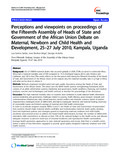| dc.description.abstract | Out of 358000 maternal deaths that occurred globally in 2008, 57.8% occurred in continental Africa.Africa had a maternal mortality ratio of 590 compared to 14 in developed regions, 68 in Latin America and Caribbean, and 190 in Asia. This article reflects on the discussions held during the Fifteenth Assembly of the Heads of State and Government of the African Union on the reasons why the maternal mortality ratio is so high in Africa and what can be done to reduce it. Methods employed included panel and open public discussions among the Heads of State and Government of the African Union. The article uses the WHO health systems strengthening framework, which consists of six pillars (information systems, leadership and governance, health workforce, financing, and medical products, vaccines and technologies, and health services) to describe the proceedings of the discussions.The high maternal mortality ratios in countries were attributed to weak national health information systems; leadership and governance challenges related to poverty, health illiteracy, poor transport networks and communications infrastructure, risky cultural practices, armed conflicts and domestic violence, dearth of women empowerment; inadequate levels of skilled birth attendants; inadequate domestic and external funding; stock-outs of consumable inputs; and limited coverage of maternal and child health interventions. In order to accelerate progress towards MDGs 4 and 5, the Heads of State and Government recommended that countries should make maternal deaths notifiable and institutionalize maternal death audits; develop,
fund and implement policies and strategies geared at improving maternal, newborn and child health;accelerate inter-sectoral action to address the broad health determinants; increase the number of skilled birth attendants; fulfil commitment to allocate at least 15% of the national budget to the health sector and allocate adequate resources to prevent stock-outs of essential medicines and reproductive health commodities;leverage health promotion approaches to raise nationa
l awareness; and ensure that there is a health centre within a radius of four kilometres equipped to provide good quality integrated maternal, newborn and child health services.here was consensus among the discussants that there was urgent need to speed up actions for strengthening health systems to improve coverage of maternal, newborn and child health services; and to address broad determinants of women, newborn and children’s health for sustained improvements in health and other development goals. | en_US |

